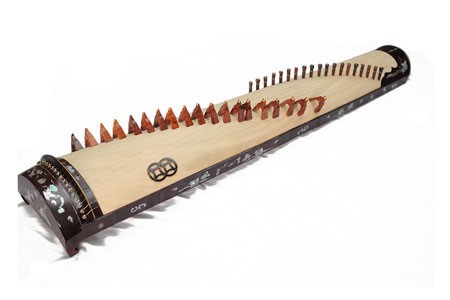A: First, we’d like to welcome a new listener to VOV, Mr. Sharwan Kumar Gandveer of India. In his first email to VOV, he wrote: “I’m a new listener of Radio the Voice of Vietnam. I like all of your radio programs. I like your website very much. Happy New Year 2018.”
 16-stringed zither, Vietnam's traditional musical instrument 16-stringed zither, Vietnam's traditional musical instrument |
B: Thank you, Mr. Gandveer, for tuning in to VOV broadcasts. We’ll send you program schedules and frequency lists. We hope to receive more feedback from you.
A: Philip Braun of the US sent us his first reception report for VOV broadcasts on November 19th and 20th this week saying that he has been a shortwave listener since 1966.
B: Welcome to VOV, Mr. Braun. In addition to shortwave broadcast, we also make our program available on the internet at vovworld.vn and on mobile apps. By providing various channels for our listeners, we hope to help people around the world better understand Vietnam, its land and people. We look forward to hearing more from you and will send a QSL card to confirm your report.
A: We welcome back Mr. Ashik Eqbal Tokon of Bangladesh after a break of quite a few months. He wrote: “First of all, I regret my break of communication over the last couple of months. It’s really pity to miss you from the SW dial. But all the time you were in my mind. Especially in November, I felt you while travelling from Thailand to Incheon. Over the sky, I felt you, my loving Vietnam.”
B: It’s great to receive your feedback again, Mr. Tokon. We hope to see you in Vietnam one day.
A: Writing to VOV this week, Adinda de Boer of the Netherlands said: “Great to hear you again! When I lived in Amsterdam i had good short wave reception. Where I live now it is very bad, so I am glad I can listen to you on my computer. My question is the following: does Vietnam have traditional instruments and are they still used now? Warm greetings from the Netherlands!”
A: Viet Nam is home to 54 ethnic groups, each with its own customs and traditions. Those groups have created a variety of traditional musical instruments, which have played an important role in Vietnamese people’s lives. The many types of musical instruments found in Vietnam include "monochord zither", "moon-shaped two-string lute", and “pear-shaped lute with four strings”. One of the best-known musical instruments is the Đàn Tranh or 16-string zither.
B: The Vietnamese 16-String zither is considered the “Princess" of Vietnam's traditional plucked string instruments. The Zither can be played as a solo instrument or accompany by other instruments in traditional orchestras.
A: The body of the zither measures 100 to 120 cm. The large end is 17-30 cm wide. The narrow end is 12-20 cm wide. The two ends of the instrument are made of hard wood and the sound box is made of Vietnamese “Wootung” wood fashioned into a semi-circular shape. The bottom is a thin, flat piece of wood. The convex surface is considered the sky or Yang, and the flat base is the earth, or Yin. The flat base often has three holes. The first hole, a half circle shape, is where the player inserts his fingers to change broken strings. The hole in the middle is the sound hole and often has a rectangular shape. This is where the musician can insert his fingers to carry the instrument. The third hole, about 1-centimeter in diameter, is used to hang the instrument on the wall.
B: At the head of the 16-string zither, there is a bent copper wire used as a bridge to support 16 stainless steel strings. The strings used to be made of twisted silk or brass. The 16 strings symbolize the 12 months and 4 seasons of a year. The strings run from the bridge to the other end of the zither and wind around 16 wooden pegs. The strings are also supported in the middle by 16 “wild geese” that have the shape of an inverted letter “V”, which can be moved to change the pitch.
 Dan bau, or monochord, a typical Vietnamese musical instrument is the Dan bau, or monochord, a typical Vietnamese musical instrument is the |
B: Another typical Vietnamese musical instrument is the dan bau, or monochord. The dan bau has a simple design and is made of materials widely available in Vietnam. The bamboo tube once used to make the body of the instrument has been replaced by a rectangular wooden box 1 meter in length. A string is stretched between two fixed bridges. A bigger bridge, a 50-70 cm bamboo or buffalo horn stick, is linked to a sound box made from a dried gourd. The steel string used to be made of rattan or silk.
A: The player plucks the string of the monochord with his or her fingers, or a plectrum while manipulating the bridge. The Dan bau produces sounds that contain multiple frequencies. It has two main parts: the plectrum which strikes notes and the bridge which like guitar frets, changes the pitch.
A: The dan bau is used in almost every Vietnamese traditional music genre: Xam singing, Cheo popular opera, Cai luong renovated theatre, and Hue royal court music. The dan bau is also played in some contemporary performances of pop or world music.
B: In an email to VOV this week, Leonardo Santiago of Venezuela informed us that he had received VOV’s QSL cards and was impressed with the picture: “In the card, there is a photograph of the Long Bien bridge which was designed by French architect Gustave Eiffel. Also, beside of the railway, I can see a man riding a bike, which is a popular vehicle in many Asian countries. Thank you so much for the card. I do appreciate it very much.”
A: Mr. Santiago asked why the Voice of Vietnam does not use an interval signal to end its daily program and whether we used one in the past. Actually, we have a fixed format for our shortwave broadcasts. Sometimes, we play music or songs to end our program depending on the content of the program. We have a signature tune at the beginning of the program but we don’t use an interval signal to end it. We have limited time for our broadcasts and we want to make it as effective, entertaining, and informative as possible.
 VOV staff with Gerry Neumann, a UK listener VOV staff with Gerry Neumann, a UK listener |
B: This week, Gerry Neumann, a VOV regular listener from the UK visited our office and presented us with beautiful 2018 calendars and a notebook. We highly appreciate them. Gerry has been listening for VOV for a very long time and has visited us a few times when he has come to Vietnam to see his friends.
 Gerry Neumann's gifts for VOV Gerry Neumann's gifts for VOV |
A: This week, we also received letters and emails from Fumito Hokamura of Japan, Ms Priya Sharma, Shivendu Paul, and SB Sharma of India, and Richard Nowak of the US. We greatly appreciate your feedback and comments on the technical aspects of our programming. We’ll confirm your reports with QSL cards soon.
A: We welcome your feedback at: English section, VOVworld, Radio the Voice of Vietnam, 45 Ba Trieu Street, Hanoi, Vietnam. Or you can email us at: englishsection@vov.org.vn. You’re invited to visit us online at vovworld.vn, where you can hear both live and recorded programs. Check out our VOV Media App available on both IOS and Android platforms to hear our live broadcasts. We look forward to your feedback on the mobile version of vovworld.vn. Once again, thank you all. Good bye until next time.